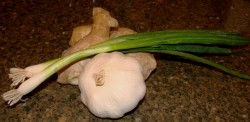Creating Your Own Foolproof Chinese Stir Fry: Introducing Barbara’s Rules of Three
I’ve been thinking a lot recently, in large part, because with a nursing infant in my lap, I do a lot of sitting still. And since I am not particularly good at sitting still and doing nothing, I let my brain wander as it will. Some part of my person, at least, gets to move, and these days, it has been my thoughts.
And I have been thinking a lot on cooking in general, and Chinese cooking in specific. And even more specific, the art of stir frying, and how to simplify it further than I have before, without losing the essential Chinese nature of it.
One of my goals in presenting my thoughts on Chinese cookery is to get readers comfortable enough in the techniques that are fundamental to the Chinese kitchen that they can release themselves from reliance upon recipes and learn how to create their own dishes. My reasoning for this is simple: cuisines are continually in flux, and they evolve over time. With each cook who learns a style of cookery and takes it beyond the cookbook and begins to play riffs based upon established themes, that cuisine grows. Also, I think that the best food in the world often comes from people who are not using a recipe at all, but are cooking from the heart, with what they have on hand, and with the equipment they have in the kitchen.
In writing my series of three posts on the art of stir frying and my introductions to basic ingredients of the Chinese pantry, I have given readers some tools to make their stir-fried dishes better than they were before, but I want to give them a leg up to the next level of cooking.
I want readers to leave the recipes behind and cook from their hearts.
Which is where my “Rules of Three” come into play. They arose from me sitting and feeding Kat while in my head, mulling over and deconstructing the ingredients and methods of Chinese stir frying, then codifying them into a handy-dandy, easy to remember, yet flexible set of guidelines.
Three is a magic number. Yes it is, it’s a magic number. We all know that–at least, all of us Americans of a certain age who grew up watching Schoolhouse Rock know that.
And since it is such a magic number, it should come to no surprise to you that I have found it to be a useful mnemonic to help folks learn how to create their own Chinese style stir-fries that not only taste good, but are easy to make.
And the beauty of my “Rules of Three” is this: once a cook has worked with them and started making some pretty darned awesome stir-fries, she can start meddling with the formula, and add a little bit of this or that. The magical symmetry of the number three will be lost, but that is the way of all rules; when they become constricting, they are modified or discarded, and the world is better for it.
So don’t look at these rules as cast in iron or carved in stone; I am no culinary Moses, bringing wisdom down from on high. I see my Rules of Three as training wheels for a wok; they are nothing but tools to help beginners get their balance before riding off on their own creativity. My goal is to have readers use these rules to loose themselves from the constraints of cookbooks, and create stir fry dishes which are uniquely their own, but which still taste authentically Chinese–which is what most Chinese and Chinese American home cooks do every day.
The “Rules of Three” are simple. Essentially, one can gather the basic components of a simple Chinese stir fry into groups of three. And, in order to make it even more special, there are three main basic components to a simple Chinese stir fry. So that adds up to three groups of three ingredients.
There is also a fourth component to a simple Chinese stir fry, which messes with the magical symmetry of my theory, but that is fine, since this fourth component serves a supportive function, and oddly enough, comes in three parts, which makes brings back to our magical mnemonic number.
The three main components to a simple Chinese stir fry are the main ingredients, the aromatics and the condiments. The fourth component is the supporting ingredients which serve purely structural and functional roles in the recipe.
So, in a nutshell, Barbara’s “Rules of Three” for making simple Chinese stir fries are thus:
Take three main ingredients.
Add three aromatics.
Add three condiments.
Apply heat and three supporting ingredients.
Voila!
You have a simple Chinese stir fry that tastes great, and didn’t require a recipe.
In the next few days, I will be elaborating on each step of this process, outlining in detail the main ingredients, aromatics, condiments and support ingredients, and at the end, will present a vegetarian recipe Morganna made up for dinner the other night using these principles.
When I am done with this series, hopefully, we will have a very useful tool for cooks, both beginners and advanced, to use when they step into the kitchen with the intention of firing up the wok and whipping up a fast, simple dinner that tastes great yet doesn’t require delving into a cookbook.
6 Comments
RSS feed for comments on this post.
Sorry, the comment form is closed at this time.
Powered by WordPress. Graphics by Zak Kramer.
Design update by Daniel Trout.
Entries and comments feeds.





I love it! I think another important thing to stir fries is being able to manage the heat. Students in my class always think they have to have super high heat the entire time – and end up burning the aromatics.
Comment by Steamy Kitchen — April 24, 2007 #
Hey Barbara,
I’m very much looking forward to this series of yours.
My latest favourite flavour combination in spiced firm tofu and bacon for the protein part of the stir fry. Absolutely magic together.
Cheers – gordon
Comment by Gordon Austin — April 27, 2007 #
I love your logical approach to this Barbara, I can see this being valuable advice to wok novices everywhere. Hopefully this post will bring about the removal of many stir-fry L plates…
Comment by Trig — April 28, 2007 #
SK–I tend to teach students with electric stoves to put the heat on high, and to get a flat bottomed wok with a single handle.
When the wok gets too hot, pull it off the burner and keep cooking. When it cools down, pop it back on and keep going.
With gas, you can turn the heat up and down as needed.
Gordon–the series is slow going, but hopefully worth it. And yes, bacon and tofu are great together!
Trig–thanks!
Comment by Barbara — May 6, 2007 #
[…] Whenever I’m trying to get rid of fridge stuff, I think about Barbara Fisher’s effortless Rule of Three. It’s a great way to toss together an easy meal without thinking hard. The idea here is that you take three main ingredients, three aromatics, three condiments, and cook. Then you might add three supporting ingredients. […]
Pingback by Raven Swallows the Sun » Stir Fry to Empty the Fridge — June 29, 2007 #
Rules of three is what all my One Page cookbooks with 1000 recipes in a page are built from. I’m so glad you discovered the same rule on your own !
/Cheers
Ramki
Comment by Ramki — August 17, 2009 #